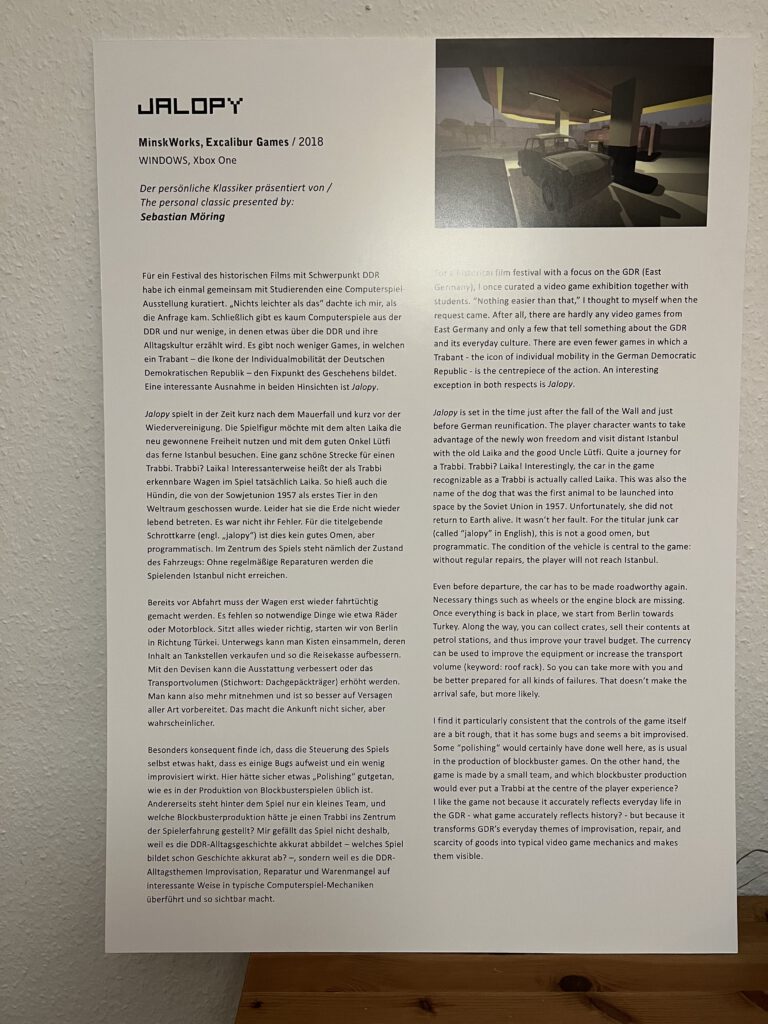Der persönliche Klassiker zuhause

[English below]
Im Mai und Juni 2023 hatte ich die große Ehre die Rubrik “Der persönliche Klassiker” des Computerspielemuseums in Berlin kuratieren zu dürfen. Ich hatte mich für Jalopy von MinskWorks und Excalibur Games entschieden, das wahrlich noch nicht alt ist (2018). Nun hat mir das Computerspielemuseum freundlicherweise das Ausstellungsschild zur Verfügung gestellt. Auf dem Schild erläutere ich, warum ich das Spiel ausgewählt habe. Und hier gibt es wie zuvor versprochen den Begleittext noch einmal zum Nachlesen:
Für ein Festival des historischen Films mit Schwerpunkt DDR habe ich einmal gemeinsam mit Studierenden eine Computerspiel-Ausstellung kuratiert. „Nichts leichter als das” dachte ich mir, als die Anfrage kam. Schließlich gibt es kaum Computerspiele aus der DDR und nur wenige, in denen etwas über die DDR und ihre Alltagskultur erzählt wird. Es gibt noch weniger Games, in welchen ein Trabant – die Ikone der Individualmobilität der Deutschen Demokratischen Republik – den Fixpunkt des Geschehens bildet. Eine interessante Ausnahme in beiden Hinsichten ist Jalopy.
Jalopy spielt in der Zeit kurz nach dem Mauerfall und kurz vor der Wiedervereinigung. Die Spielfigur möchte mit dem alten Laika die neu gewonnene Freiheit nutzen und mit dem guten Onkel Lütfi das ferne Istanbul besuchen. Eine ganz schöne Strecke für einen Trabbi. Trabbi? Laika! Interessanterweise heißt der als Trabbi erkennbare Wagen im Spiel tatsächlich Laika. So hieß auch die Hündin, die von der Sowjetunion 1957 als erstes Tier in den Weltraum geschossen wurde. Leider hat sie die Erde nicht wieder lebend betreten. Es war nicht ihr Fehler. Für die titelgebende Schrottkarre (engl. „jalopy”) ist dies kein gutes Omen, aber programmatisch. Im Zentrum des Spiels steht nämlich der Zustand des Fahrzeugs: Ohne regelmäßige Reparaturen werden die Spielenden Istanbul nicht erreichen.
Bereits vor Abfahrt muss der Wagen erst wieder fahrtüchtig gemacht werden. Es fehlen so notwendige Dinge wie etwa Räder oder Motorblock. Sitzt alles wieder richtig, starten wir von Berlin in Richtung Türkei. Unterwegs kann man Kisten einsammeln, deren Inhalt an Tankstellen verkaufen und so die Reisekasse aufbessern. Mit den Devisen kann die Ausstattung verbessert oder das Transportvolumen (Stichwort: Dachgepäckträger) erhöht werden. Man kann also mehr mitnehmen und ist so besser auf Versagen aller Art vorbereitet. Das macht die Ankunft nicht sicher, aber wahrscheinlicher.
Besonders konsequent finde ich, dass die Steuerung des Spiels selbst etwas hakt, dass es einige Bugs aufweist und ein wenig improvisiert wirkt. Hier hätte sicher etwas „Polishing” gutgetan, wie es in der Produktion von Blockbusterspielen üblich ist. Andererseits steht hinter dem Spiel nur ein kleines Team, und welche Blockbusterproduktion hätte je einen Trabbi ins Zentrum der Spielerfahrung gestellt? Mir gefällt das Spiel nicht deshalb, weil es die DDR-Alltagsgeschichte akkurat abbildet – welches Spiel bildet schon Geschichte akkurat ab? -, sondern weil es die DDR-Alltagsthemen Improvisation, Reparatur und Warenmangel auf interessante Weise in typische Computerspiel-Mechaniken überführt und so sichtbar macht.
Sebastian Möring 2023
[English version]
In May and June 2023, I had the great honor to curate the section “The personal classic” of the Computerspielemuseum in Berlin. I had chosen Jalopy by MinskWorks and Excalibur Games, which is truly not old yet (2018). Now the Computerspielemuseum has kindly provided me with the exhibition sign. On the sign, I explain why I chose the game. And here, as promised before, is the accompanying text once again for you to read:
For a historical film festival with a focus on the GDR (East Germany), I once curated a video game exhibition together with students. “Nothing easier than that,” I thought to myself when the request came. After all, there are hardly any video games from East Germany and only a few that tell something about the GDR and its everyday culture. There are even fewer games in which a Trabant – the icon of individual mobility in the German Democratic Republic – is the centrepiece of the action. An interesting exception in both respects is Jalopy.
Jalopy is set in the time just after the fall of the Wall and just before German reunification. The player character wants to take advantage of the newly won freedom and visit distant Istanbul with the old Laika and the good Uncle Lütfi. Quite a journey for a Trabbi. Trabbi? Laika! Interestingly, the car in the game recognizable as a Trabbi is actually called Laika. This was also the name of the dog that was the first animal to be launched into space by the Soviet Union in 1957. Unfortunately, she did not return to Earth alive. It wasn’t her fault. For the titular junk car (called “jalopy” in English), this is not a good omen, but programmatic. The condition of the vehicle is central to the game: without regular repairs, the player will not reach Istanbul.
Even before departure, the car has to be made roadworthy again. Necessary things such as wheels or the engine block are missing. Once everything is back in place, we start from Berlin towards Turkey. Along the way, you can collect crates, sell their contents at petrol stations, and thus improve your travel budget. The currency can be used to improve the equipment or increase the transport volume (keyword: roof rack). So you can take more with you and be better prepared for all kinds of failures. That doesn’t make the arrival safe, but more likely.
I find it particularly consistent that the controls of the game itself are a bit rough, that it has some bugs and seems a bit improvised. Some “polishing” would certainly have done well here, as is usual in the production of blockbuster games. On the other hand, the game is made by a small team, and which blockbuster production would ever put a Trabbi at the centre of the player experience? I like the game not because it accurately reflects everyday life in the GDR – what game accurately reflects history? – but because it transforms GDR’s everyday themes of improvisation, repair, and scarcity of goods into typical video game mechanics and makes them visible.
Sebastian Möring 2023






You must be logged in to post a comment.